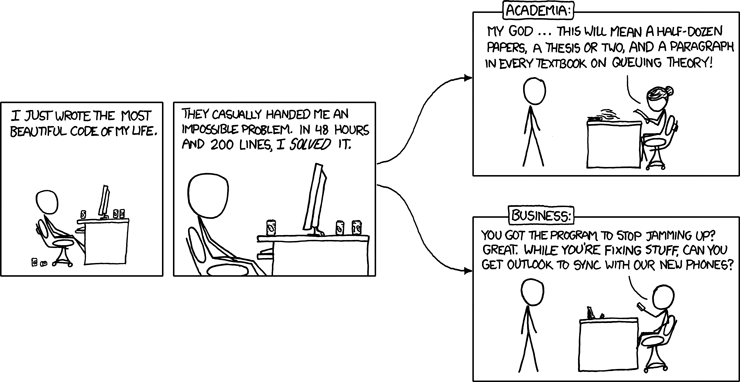As some of the undergraduate guests on Combinations and Permutations, such as Christopher Bates and Cody Palmer, prepare to take the Putnam I thought I would post a couple of links about it today. The Putnam, or more formally the William Lowell Putnam Mathematical Competition, is, according to the Wikipedia:
An annual mathematics competition for undergraduate college students of the United States and Canada, awarding scholarships and cash prizes ranging from $250 to $2,500 for the top students and $5,000 to $25,000 for the top schools. The competition was founded in 1927 by Elizabeth Lowell Putnam in memory of her husband William Lowell Putnam, who, while alive was an advocate of intercollegiate intellectual competition. The exam has been offered annually since 1938 and is administered by the Mathematical Association of America.
I recently interviewed Bruce Reznick from the University of Illinois Urbana-Champaign on Strongly Connected Components. He used to write problems for the Putnam and then decided to write a fascinating article about his experiences. From the article:
The phrase “Putnam problem” has a achieved a certain cachet among those mathematicians of the problem-solving temperament and is applied to suitable attractive problems which never appeared on the exam. One motivation for my joining the Problems Subcommittee was the aesthetic challenge of presenting the mathematical community a worthy set of problems. In fact, the opportunity to maintain this “brand name of quality” was more enticing to me than the mere continuation of an undergraduate competion. Of course, the primary audience for the Putnam must always be students, not one’s colleagues.
At the same time, the Putnam cause a few negative effect, mainly because of its difficulty. Math contests are supposed to be hard, and the Putnam is the hardest one of all. In 1972, I scored less than 50% and finished seventh. In most years, the median Putnam paper has fewer than two largely correct solutions. For this reason, the first problem in each session is designed to require an “insightlet”, though not a trivial one. We on the committee tried to keep in mind that median Putnam contestants, willing to devote one of the last Saturdays before final exams to a math test, are likely to receive an advanced degree in the sciences. It is counterproductive on many levels to leave them feeling like idiots.
Finally the Accidental Mathematician is on her first year of writing problems for the Putnam and has the following to say about the problem difficulty on the Putnam:
Well, you could call it a steep learning curve. Putnam problems are expected to be hard in a particular way: they should require ingenuity and insight, but not the knowledge of any advanced material beyond the first or occasionally second year of undergraduate studies, and there should be a short solution so that, in principle, an infinitely clever person could solve all 12 problems in the allotted 6 hours. (In reality, that doesn’t happen very often, and I’ve heard that it generates considerable attention when someone comes too close.) The problems are divided into two groups of six – A1-A6 for the morning session and B1-B6 for the afternoon session – and there is a gradation of the level of difficulty within each group. A1 is often the hardest to come up with – it should be the easiest of the bunch, but should still require some clever insight and have a certain kind of appeal. The difficulty (for the competitor, not for us) then increases with each group, with A6 and B6 the hardest problems on the exam. There are also various subtle differences between the A-problems and B-problems; this is something that I would not have been aware of if another committee member hadn’t pointed it out to me. For example, a B1 could involve some basic college-level material (e.g. derivatives or matrices), but this would not be acceptable in an A1, which should be completely elementary.
So to all of you out there about to write the Putnam, best of luck knock it out of the park.
lmS4+V4S4%7LK@O+ (z�’B(2*L�U V*%OE?N4I>+1UFS*L?@L?)7S43J+�=K+o L ),+�%OB(LK3>2 )�L?)7S4+,BL�UWEK2*XBOS*E?@O+
UFLMB(S4+�UFL�BO35),35L�2*@�E�G#B(S4+V*%OE?N4I>+1U
Q@OEKIJ=3>24XB(+�UWVp+�%7L�UW+�2BLK2*o 35@L�V4V4IJ3J+1o B(E @O’43>B(L�N*I>C
L�BABO%7LK),BO3J=K+V*%OE?N4I>+1UF@#y/S435)7S24+1=K+�%
L�V4Vp+1LK%O+oEK2B(S4++,§4L�U�}/324+!UWE�BO3J=MLMB(3>E?2GsEK%
UC
DE?3>243J24X¢BOS4+z�%(EKN*I>+1UW@
¦’4Nq),E?U
UW3>BAB(+�+�y&L?@#B(S4+L�+@DB(S4+,B(3J))7S*L�IJIJ+�24X?+�E�GV4%O+@A+12BO3J24XeB(E
B(S4+FUFLMBOS*+�UFLMB(3J)1L�I�),E?UWU’4243>BDC¢L�y&EK%OBOSCe@O+,B#E�G&V4%(EKN4IJ+�UF@1}FH:2GbL?)�B~BOS*+FEKV4VpEK%OBO’42*3|BDC
B(EUFL�3J2?B7L�3J2BOS*3J@!AN4%7L�2Po�2*L�UW+EKG¡’*L�IJ3|BDCFymLK@<UWEK%(+#+�2BO35),3J24X�BOEUW+#B(S*L�2¢BOS4+�UW+�%(+
)�EK2BO3J2’*LMB(3>E?2�EKGqLK2
‘*2*o+�%(XK%7LKo4’*LMB(+&)�EKUWVP+�BO3>BO3JEK2~}F3<G),E?’4%(@O+K�BOS4+/V4%(3JUWLK%OC�L�’*o3J+�2P),+mGsEK%
B(S4+#z�’B(2*L�U U’*@AB<L�IJy&L¤C@TNP+B(S4+#@ABO’*o+12B(@1424E�BE?24+Kº@/),E?I>IJ+1LKXK’4+@�}
ª&B.BOS*+@OLKU
+
B(3>UW+KgBOS*+z�’B(2*L�U )1L�’*@O+1@.L!Gs+1yw24+1X?L�BO3J=K+W+,«q+1),B(@1xUFL�3J24IJC¢Np+1)�LK’*@O+
EKGm3>B(@
o3>),’4I>BDCK}{eLMB(S¥),E?2?B(+1@AB(@�L�%(+@A’4V*VPE@A+oBOEeNp+�SPL�%7onL�2*oB(S4+!z¡’BO2PL�U¨3J@BOS4+
S*LK%(o4+1@ABEK2*+E�G&L�IJI}.H:2k1¯KPH<@O)�EK%(+1oIJ+1@(@<BOS*LK2° � ��L�2*o*2435@AS4+o@O+�=?+�2BOSx}rH:2UWE?@AB
C?+1L�%7@1?B(S4+.UW+1o35L�2z¡’BO2*LKU V*LKVP+1%/S*LK@&Gs+1yT+1%mBOS*LK2BDyTEWI5L�%(XK+�IJC�)�EK%(%O+)�B/@AE?I>’B(3>E?2*@1}�²4EK%
B(S43J@m%(+1L?@AE?2~?BOS4+*%7@ABmV*%OE?N4I>+1UË3>2+1L?)7S@O+1@(@O3>E?23J@/o4+1@O3>X?24+1o�BOEW%(+1’43J%O+L�2kA3J2*@A3JXKSB(I>+�B(4
B(S4EK’4X?S�24E�B<L
B(E�B(LKI>IJCB(%O3J=3JLKI~EK2*+K}¡t+.EK2�B(S4+�RTEKUWUW3>BABO+1+.BO%(3J+1o!BOE6?+�+1V3J2�UW3>2*oB(S*LMB
UW+1o43JLK2Wz¡’BO2PL�Uw)�EK2BO+@DB7L�2B(@1�y/3JI>IJ3J24XBOE#o+1=KEKBO+/EK2*+&EKGPB(S4+I5LK@ABT¦LMB(‘4%7o4L¤C@�NP+�GsEK%(+m*2*L�I
+�§LKUF@nBOEWL#UFL�BOSB(+1@AB1L�%(+<IJ3J6K+�IJC
BOE�%O+),+�3J=K+rL�2�L?o=ML�2*)�+1oo4+�XK%(+�+<3>2�BOS4+@O)�3>+12*),+@�}�HBm3J@
)�EK’42BO+1%OV*%OEo’*),BO3J=K+rEK2UFL�2CIJ+�=K+1IJ@&B(EWI>+L¤=K+rBOS4+1U
Gs+1+�IJ3>24XWIJ3>6?+BOEKB(L�I35o3JE�B7@�}
¦’*)1),+@O@¡EK2WBOS*+RTEKUWVp+,B(3|B(3>E?2%O+’43>%(+1@�UWL�BOS4+1UFLMBO35)�LKIPLKN43>IJ3>BDC
LK2*oWV4%(EKN4IJ+�U
Q:@AE?I>=3J24X
